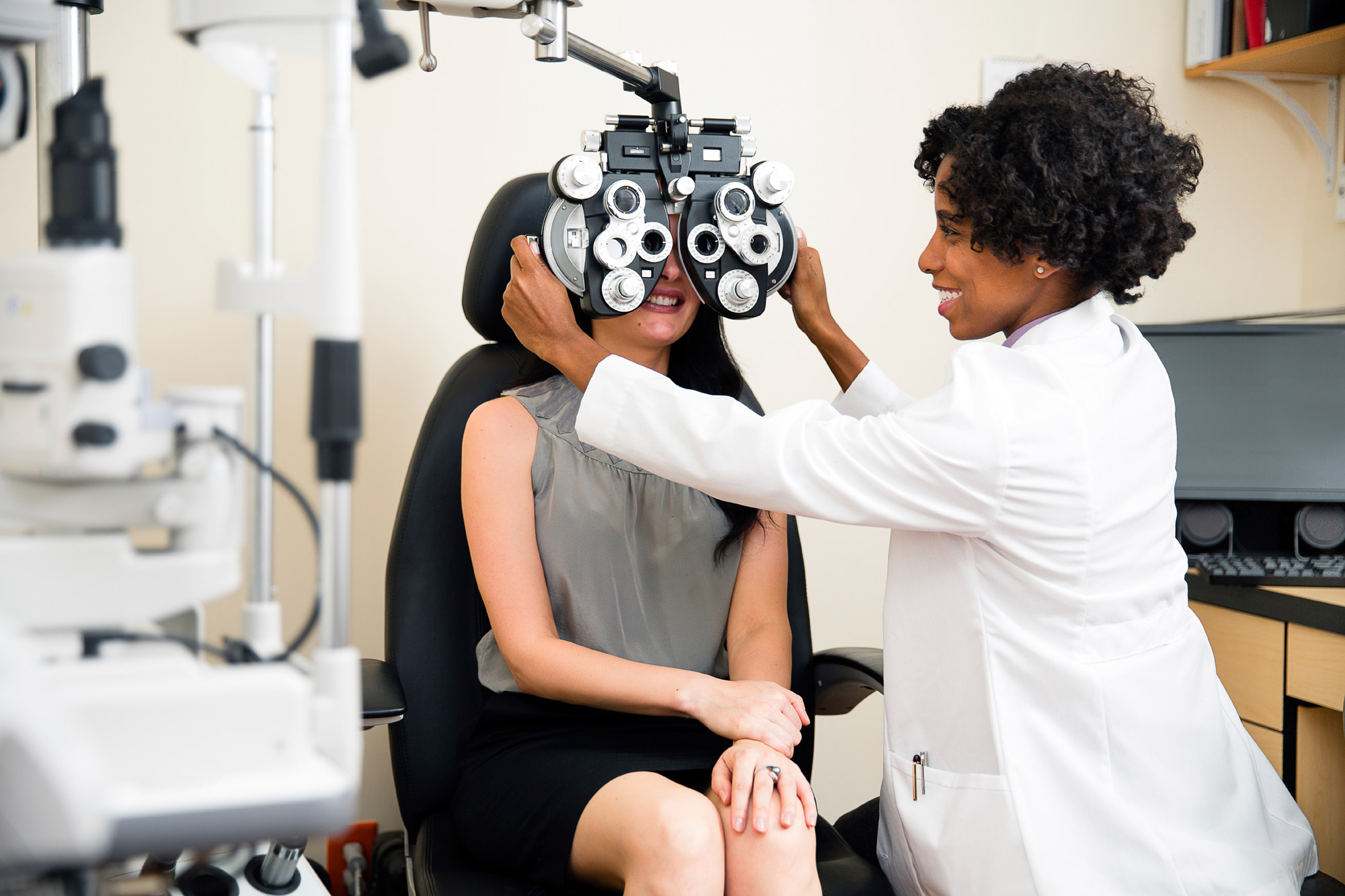Last Updated: March 29, 2023
Video: What is the difference between a sight test and an eye exam? | Dr. Jeff Goodhew
In some provinces, a number of optical stores offer “sight tests” or “vision tests” that use automated equipment to measure any refractive error or glasses prescription. A sight test is not is not a comprehensive eye exam that is conducted by your optometrist.
With regular comprehensive eye exams, your optometrist will examine, diagnose, treat, manage and prevent diseases and disorders affecting the visual system, the eye and related structures, in addition to checking an individual’s prescription and prescribing eyewear. Optometrists also prescribe medications to treat certain eye conditions, such as infections, inflammations, allergies and injuries.
What is a sight test?
A sight test describes a procedure where a person’s glasses prescription or refraction is determined by relying on a combination of computerized tests using automated equipment.
The accuracy and comprehensiveness of these automated sight tests is limited. Eye muscle coordination is unaccounted for. Eye fixation, eye alignment, pupil size, corneal or lens irregularities, movement, attention, and something called instrument myopia can influence the test results. Instrument myopia is created by the eye’s tendency to over-focus when looking through a machine which tends to lead to inaccurate measurements of the glasses prescription.
Furthermore, sight tests do not examine the health of the eye and they overlook serious eye conditions and diseases. Some serious eye conditions such as glaucoma, age-related macular degeneration and diabetic retinopathy do not cause noticeable symptoms before they cause serious and irreversible damage to the eye. These can only be picked up early in time for intervention with a comprehensive eye exam performed by your optometrist.
What is a comprehensive eye exam?
During the comprehensive eye exam an optometrist looks at the entire eye and visual system, as well as your prescription. Think of a comprehensive eye exam as a physical for your eyes. It is an important part of preventive health care. Comprehensive exams can detect eye diseases and disorders such as dry eyes, cataracts, age-related macular degeneration, diabetic retinopathy, glaucoma, and retinal detachments. Comprehensive exams can also help detect systemic health problems such as diabetes, hypertension, some cancers, and much more.1-8
An optometrist may use automated computerized instruments to provide an estimate of your prescription prior to performing a more detailed refraction test; but importantly, they use their extensive training and experience, and professional judgment, to direct the testing and interpret the results. Only on this basis can an accurate prescription be determined and customized to the patient’s visual needs.
Eye and health conditions that be detected through an eye exam:1-8
- Cataracts: distorted or cloudy vision caused by the lens inside the eye losing its transparency over time. Treatment options include getting updated glasses or surgical removal. Wearing UV protective sunglasses helps to delay the onset and progression of cataracts.
- Age-related macular degeneration (AMD): degenerative changes to the back of the eye that affects central vision. It is the leading cause of vision loss among older adults.
- Diabetic Retinopathy: a weakening of the tiny blood vessels in the back of the eye due to uncontrolled blood sugar levels in people with diabetes. It results in bleeding, growth of new abnormal blood vessels, and swelling of the retina, leading to vision changes. If left untreated, blindness may result.
- Glaucoma: also known as the “silent thief of vision” as it often has no visual symptoms until significant damage has occurred. It causes damage to the nerve tissue at the back of the eye which is often linked to increased eye pressure. If not detected and treated at an early stage, irreversible vision loss may result.
- Retinal detachment: a condition where the retina partially or completely peels away from the back of the eye. Once it is detached, the retina stops working and light signals cannot get back to the brain to be processed. To the patient, partial or complete vision loss occurs. Depending on the severity of the detachment, vision loss can be severe and permanent.
- Eye tumors
- Hypertension and cardiovascular diseases that can lead to stroke
- Brain injuries including strokes other and neurological conditions
- Brain tumors – cancerous or benign (non-cancerous)
An eye exam includes:9
- Case history including the patient’s identifying information, chief vision concerns, past and present vision status, medical background, and family history.
- Analysis of the patient’s visual needs at home, work, school and play. In some instances, this may necessitate questions about the patient’s school/work environment and recreational activities, in order to accurately determine the patient’s visual demands.
- Measurement of the visual acuity of each eye, individually and together, with and without corrective lenses, at distance and near.
- Diagnosis of the refractive status or prescription, based on a combination of objective (measured by the optometrist) and subjective (patient responses to questions) techniques.
- Assessment of the binocular vision status (ability to see using both eyes together), including eye alignment, eye movements, eye coordination, focusing ability, depth perception, or in some cases, hand-eye coordination.
- Neurological assessment of the visual system including a review of the pupil reactions, ocular motility, and peripheral vision.
- Assessment of eye health including structures outside the eye using a biomicroscope, to check for eye conditions such as dry eye, pink eye, stye, blepharitis, lumps on the eyelids, etc.
- Assessment of eye health including structures inside the eye using a biomicroscope, to check for eye conditions such as cataracts, glaucoma, macular degeneration, diabetic retinopathy, retinal detachment, etc.
- Additional testing may be needed based on the results of the previous tests to confirm or rule out possible problems, to clarify uncertain findings, or to provide a more in depth assessment. These can include, but are not limited to retinal photography, optic nerve or macular scans (OCT, GDx, HRT), automated visual field testing, ultrasound, gonioscopy, fluorescein staining, corneal pachymetry, contrast sensitivity, additional binocular vision testing, and colour vision testing.
- All of the test results above are used in the final analysis to determine the appropriate prescription glasses to treat refractive problems, to develop a program of eye training exercises, or to recommend medical or surgical treatment.
- Recommendations for future eye care can be made based on the history of eye health and the results of the examination.
References
- Canadian Diabetes Association. (2020). Diabetes in Canada. Retrieved from Diabetes Canada: https://www.diabetes.ca/DiabetesCanadaWebsite/media/Advocacy-and-Policy/Backgrounder/2020_Backgrounder_Canada_English_FINAL.pdf
- Government of Canada. (2017). Diabetes in Canada. Retrieved from Government of Canada Website: https://www.canada.ca/en/public-health/services/publications/diseases-conditions/diabetes-canada-highlights-chronic-disease-surveillance-system.html
- Dunbar MT. Co-management of patients with diabetes. Optom Clin. 1994;4(2):43-62.
- Hurcomb PG et al. Ocular signs of systemic hypertension: a review. Ophthal Physiol Opt. 2001;21(6):430-440.
- Cockburn DM. Parkinson's disease: a review of the medical and optometric aspects. Clin Exp Optom. 1991;74(1):15-18.
- Chu, Edward. Eye on stroke prevention: many of our patients at risk for stroke don't know the first signs of it. Primary care optometrists can detect, and even help patients avoid, a stroke. Rev Optom. 2013;150(6)40-46.
- Ciuffreda Kj et al. Vision therapy for oculomotor dysfunctions in acquired brain injury: A retrospective analysis. J Am Optom Assoc. 2008;79(1):18-22.
- Hoppe E et al. Optometrists as key providers in prevention and early detection of malignancies. J Am Optom Assoc. 2006;77(8):397-404.
- Hyrnchak P. (2008). Procedures in clinical optometry. School of Optometry, University of Waterloo.

